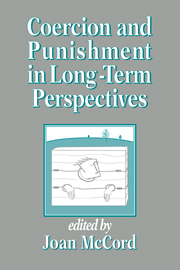Book contents
- Frontmatter
- Contents
- List of contributors
- Acknowledgments
- 1 Introduction: coercion and punishment in the fabric of social relations
- I Mental health, coercion, and punishment
- II Family socialization practices and antisocial behavior
- 5 Coercion as a basis for early age of onset for arrest
- 6 Disentangling mother–child effects in the development of antisocial behavior
- 7 Family and child factors in stability and change in children's aggressiveness in elementary school
- 8 Kindergarten behavioral patterns, parental practices, and early adolescent antisocial behavior
- 9 The reciprocal influence of punishment and child behavior disorder
- 10 The development of coercive family processes: the interaction between aversive toddler behavior and parenting factors
- III Aggression and coercion in the schools
- IV Deviance, crime, and discipline
- V Measuring and predicting in studies of coercion and punishment
- Name index
- Subject index
9 - The reciprocal influence of punishment and child behavior disorder
Published online by Cambridge University Press: 29 September 2009
- Frontmatter
- Contents
- List of contributors
- Acknowledgments
- 1 Introduction: coercion and punishment in the fabric of social relations
- I Mental health, coercion, and punishment
- II Family socialization practices and antisocial behavior
- 5 Coercion as a basis for early age of onset for arrest
- 6 Disentangling mother–child effects in the development of antisocial behavior
- 7 Family and child factors in stability and change in children's aggressiveness in elementary school
- 8 Kindergarten behavioral patterns, parental practices, and early adolescent antisocial behavior
- 9 The reciprocal influence of punishment and child behavior disorder
- 10 The development of coercive family processes: the interaction between aversive toddler behavior and parenting factors
- III Aggression and coercion in the schools
- IV Deviance, crime, and discipline
- V Measuring and predicting in studies of coercion and punishment
- Name index
- Subject index
Summary
The association between punishment and conduct problems has been the subject of numerous investigations over the past two decades (Farrington, 1978; Hawkins, Catalano, & Miller, 1992; Holmes & Robins, 1988; McCord, 1979; Tremblay et al., 1991). That punishment is related to conduct problems is now beyond question. Hawkins, Catalano, and Miller (1992) have reviewed findings from several cross-sectional and prospective studies showing a relationship between punishment and conduct problems. Intervention studies have also indicated that children benefit from appropriate parental discipline (Hawkins, Catalano, Jones, & Fine, 1987; Patterson, 1982; Tremblay et al., 1991; Wahler & Dumas, 1987). Despite the fact that studies have varied with regard to assessment of punishment and conduct problems and in sample composition, the findings converge in the conclusion that youngsters who are exposed to punishment have higher rates of delinquency.
What accounts for the linkages between punishment and conduct problems? The effect may be causal in that parental punishment converts preexisting tendencies into later delinquency. According to this hypothesis, conduct problems and antisocial behavior are, in part, consequences of inadequate discipline. This could come about in several different ways. Several notable theorists (e.g., Hirschi, 1969) concur that difficulties in rearing interfere with the development of attachments that would insulate the adolescent from conduct problems. Another mechanism for a causal effect of punishment is through the modeling of coercive and aggressive behavior that (inadvertently) teaches children the very behavior it is designed to suppress.
- Type
- Chapter
- Information
- Coercion and Punishment in Long-Term Perspectives , pp. 154 - 164Publisher: Cambridge University PressPrint publication year: 1995
- 21
- Cited by

